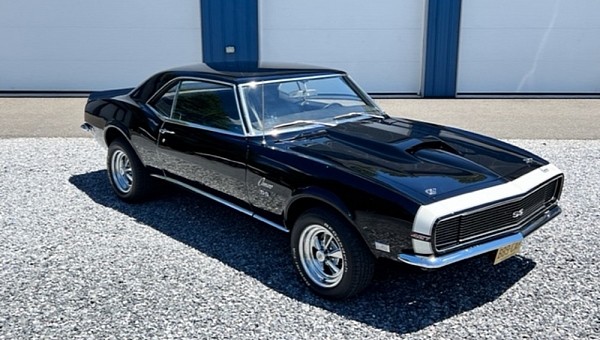The 1968 Baldwin-Motion 427 Camaro RS/SS was a collaboration between two New York-based companies - a speed shop called Motion Performance and Chevy dealer Baldwin Chevrolet.
The concept behind their idea that began in 1967 was to create a faster Camaro similar to what Shelby did for the Ford Mustang by swapping out the factory installed 396 cubic-inch engine (the largest available for the Camaro) for the 427 cubic-inch 425hp V8 that was optional in the Corvette.
Despite the engine swap, upgrades to the suspension including traction bars to address the Camaro's habit of wheel hop, and other performance parts available, the cars were sold with factory warranties intact.
Ultimately, the Chevelle, Chevy II, Corvette, and Biscayne models would join the Camaro in the program, which would be dubbed "Fantastic Five." The Baldwin-Motion dyno-tuned Phase III SS-427 Camaro was advertised as being able to achieve 11-second quarter mile times guaranteed.
While it is not clear how many 1968 Baldwin-Motion Camaros were built and sold, there is one that will present itself at the Barrett-Jackson Scottsdale collector car auction the last week of January 2023.
The unrestored car being sold at No Reserve has the original Motion Performance 427 V8 under the hood, with the OEM intake with the 3-barrel Motion Performance mods accommodating the original 3-barrel Holley carb topped off with a "Fly-Eye" air cleaner. Fuel is delivered courtesy of a trunk-mounted electric fuel pump.
Power reaches the rear by way of a GM matching VIN stamped close-ratio M21 4-speed manual tranny fitted to the big block by way of Motion installed Lakewood bell housing concealing an aluminum flywheel. The original LAB Machine traction bars help keep the original GM 4.56 positraction-coded rear end with stick-welded tubes by Motion Performance in line.
Documents including a letter from the National Corvette Restorers Society (NCRS), the original cowl tag, as well as engine broach marks, and machine codes confirm the authenticity of the original build date, engine, and interior/ exterior color combination. In addition, the car is said to have all its original sheet metal and paint, the original interior with a Motion-installed Sun tachometer, and the original Hurst shifter.
Despite the engine swap, upgrades to the suspension including traction bars to address the Camaro's habit of wheel hop, and other performance parts available, the cars were sold with factory warranties intact.
Ultimately, the Chevelle, Chevy II, Corvette, and Biscayne models would join the Camaro in the program, which would be dubbed "Fantastic Five." The Baldwin-Motion dyno-tuned Phase III SS-427 Camaro was advertised as being able to achieve 11-second quarter mile times guaranteed.
While it is not clear how many 1968 Baldwin-Motion Camaros were built and sold, there is one that will present itself at the Barrett-Jackson Scottsdale collector car auction the last week of January 2023.
The unrestored car being sold at No Reserve has the original Motion Performance 427 V8 under the hood, with the OEM intake with the 3-barrel Motion Performance mods accommodating the original 3-barrel Holley carb topped off with a "Fly-Eye" air cleaner. Fuel is delivered courtesy of a trunk-mounted electric fuel pump.
Power reaches the rear by way of a GM matching VIN stamped close-ratio M21 4-speed manual tranny fitted to the big block by way of Motion installed Lakewood bell housing concealing an aluminum flywheel. The original LAB Machine traction bars help keep the original GM 4.56 positraction-coded rear end with stick-welded tubes by Motion Performance in line.
Documents including a letter from the National Corvette Restorers Society (NCRS), the original cowl tag, as well as engine broach marks, and machine codes confirm the authenticity of the original build date, engine, and interior/ exterior color combination. In addition, the car is said to have all its original sheet metal and paint, the original interior with a Motion-installed Sun tachometer, and the original Hurst shifter.
This unrestored black 1968 Baldwin-Motion #Camaro RS/SS maintains its original 427/425hp V8. It will be crossing the auction block at the 2023 Scottsdale Auction with No Reserve, January 21-29 at WestWorld.
— Barrett-Jackson (@Barrett_Jackson) November 18, 2022
Read more: https://t.co/S9JZju7gJ4 pic.twitter.com/LVzV4f1A1B





